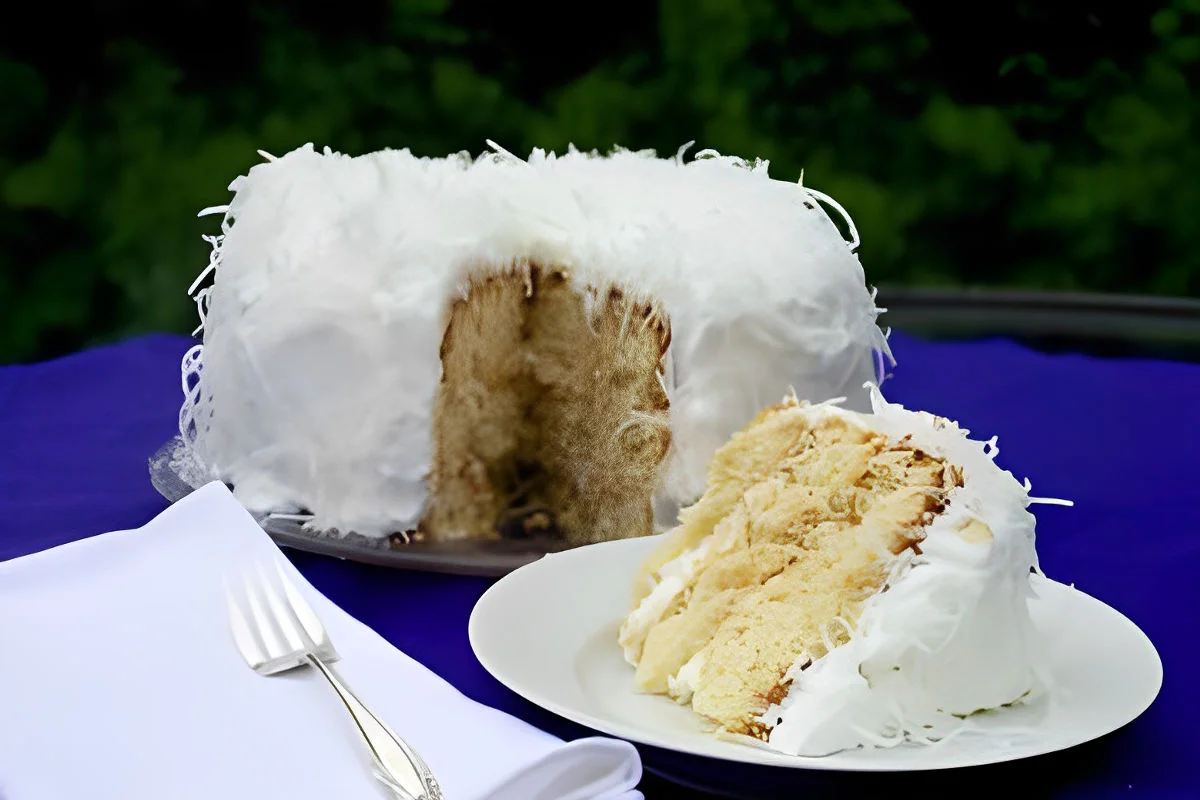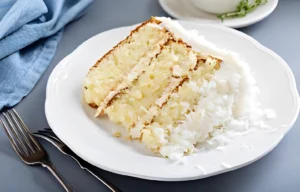Introduction to Coconut Cake
Coconut cake, a beloved dessert known for its moist, fluffy texture and rich coconut flavor, stands as a testament to the versatility of coconut in baking. This classic treat, often associated with festive occasions and southern hospitality, has roots that span various cultures and cuisines, each adding its unique twist to the recipe. The perfect coconut cake recipe balances the sweetness of sugar with the tropical freshness of coconut, achieved through a blend of coconut milk, shredded coconut, and, in some cases, coconut extract.
The allure of coconut cake lies not just in its taste but also in its presentation, with layers of soft cake sandwiched with creamy frosting and adorned with a sprinkle of coconut flakes. Whether you’re a seasoned baker or a novice eager to try your hand at this delightful dessert, understanding the components and techniques behind a coconut cake is key to mastering the recipe.
In this comprehensive guide, we’ll explore the essential ingredients, step-by-step instructions, and expert tips to help you bake the ultimate coconut cake. From selecting the right type of flour to achieving the perfect frosting consistency, we’ll cover everything you need to know to impress your guests with a stunning and delicious coconut cake.
Ingredients and Substitutions
Main Ingredients
The journey to baking the perfect coconut cake starts with understanding its main ingredients. Each component plays a pivotal role in creating the cake’s signature texture and flavor.
- Flour: The foundation of any cake, the type of flour used can significantly affect the texture. All-purpose flour offers a reliable structure, while cake flour, with its lower protein content, makes for a lighter, more tender crumb. For a coconut cake recipe, achieving a delicate balance between softness and structure is key.
- Coconut Varieties: The essence of coconut cake comes from incorporating coconut in various forms. Coconut milk enriches the batter with moisture and subtle flavor, while coconut extract can intensify the tropical aroma. Shredded coconut adds texture to the cake and decoration, and for those seeking an even deeper coconut taste, coconut flour can be used, albeit sparingly, due to its high absorbency.
- Sweeteners: The choice between granulated and powdered sugar can affect the cake’s sweetness and texture. Granulated sugar is standard for the batter, providing sweetness and aiding in the creaming process, while powdered sugar is preferred for smooth, spreadable frostings.
Substitutions for Dietary Restrictions
Catering to dietary restrictions doesn’t mean compromising on taste or texture. Here are some thoughtful substitutions:
- Gluten-Free Flour Alternatives: A blend of gluten-free flours and starches can replace all-purpose flour for those avoiding gluten, ensuring everyone can enjoy this delightful dessert.
- Dairy-Free Substitutes: Coconut milk and oil not only enhance the coconut flavor but also serve as excellent dairy-free alternatives to traditional milk and butter, making the cake more accessible.
- Vegan Options: For a vegan coconut cake, egg substitutes such as applesauce or flaxseed meal can be used, along with vegan butter for the frosting, ensuring that the cake remains moist and flavorful.
Step-by-Step Recipe
Creating a coconut cake that’s both delicious and visually appealing involves a few critical steps, from preparing the batter to baking and finally, frosting the cake. Here’s a detailed guide to help you through the process.
Preparing the Batter
- Mixing Dry and Wet Ingredients: Start by sifting together your chosen flour, baking powder, and a pinch of salt in a large bowl. In a separate bowl, whisk together wet ingredients like coconut milk, vanilla extract, and, if desired, coconut extract to amplify the tropical flavor. Creaming the sugar and butter (or oil) together until light and fluffy is crucial for incorporating air into the batter, ensuring a light texture.
- Incorporating Coconut Flavor Effectively: For an authentically rich coconut taste, add shredded coconut into the batter. This not only infuses the cake with a subtle coconut texture but also enhances the overall flavor profile. Be mindful of the balance between the extracts and the actual coconut components to avoid overpowering the cake with artificial tastes.
Baking the Cake
- Optimal Temperatures and Times: Preheat your oven to 350°F (175°C) for even baking. Pour the batter into prepared pans, smoothing the top with a spatula. Bake for 25-30 minutes or until a toothpick inserted into the center comes out clean. Even baking is key to a moist cake, so avoid opening the oven door frequently.
- Tips for a Moist Cake: To keep the cake moist, avoid overbaking. Once done, let the cakes cool in the pans for about 10 minutes before transferring them to a wire rack. This prevents the cake from becoming dry. A simple syrup soak or brushing with coconut milk can also add moisture and flavor to the cake layers before frosting.
Frosting and Decoration
- Cream Cheese vs. Buttercream Frosting: For the frosting, you can choose between cream cheese for a tangy contrast or buttercream for a sweet, smooth finish. Both options pair wonderfully with the coconut flavor, but cream cheese frosting adds a delightful richness that complements the cake’s texture.
- Decorating with Coconut Flakes and Other Toppings: Once frosted, press shredded coconut onto the sides and top of the cake for a classic look. Toasting the coconut flakes beforehand can add an extra layer of flavor and texture. For a more festive appearance, garnish with edible flowers, lime zest, or chopped nuts.
Variations of Coconut Cake
Exploring variations of the classic coconut cake recipe allows bakers to cater to a wide range of tastes and occasions. Each variation maintains the essence of coconut while introducing complementary flavors or adapting to dietary preferences. Here are some delightful twists on the traditional coconut cake:
Classic Coconut Cake
The Classic Coconut Cake is a timeless favorite, featuring layers of soft, fluffy cake infused with coconut milk and extract, then frosted with a creamy coconut buttercream. It’s adorned with a generous sprinkling of shredded coconut, offering a pure, unadulterated coconut experience. This version is perfect for those who appreciate the traditional flavors that have made coconut cake a beloved dessert across generations.
Chocolate Coconut Cake
For chocolate lovers, the Chocolate Coconut Cake presents a decadent twist. This variation incorporates cocoa powder into the batter, creating rich, chocolatey layers that contrast beautifully with the lightness of coconut. The cake is often filled and topped with a smooth coconut cream frosting, and garnished with toasted coconut flakes, combining the best of both worlds in every bite.
Lemon Coconut Cake
The Lemon Coconut Cake introduces a tangy zest to the sweet, tropical flavors of coconut. Lemon juice and zest are added to the batter, and the cake is layered with a lemon-infused frosting, offering a refreshing citrus note that cuts through the richness. This variation is especially popular in the spring and summer months, serving as a bright and uplifting dessert option.
Vegan Coconut Cake
Catering to dietary preferences, the Vegan Coconut Cake ensures everyone can enjoy the delightful flavors of coconut cake. This version uses plant-based ingredients, such as dairy-free milk and vegan butter, and egg substitutes like applesauce or aquafaba. The result is a moist, tender cake that doesn’t compromise on taste or texture, proving that vegan desserts can stand toe-to-toe with their traditional counterparts.
Each of these variations showcases the versatility of coconut cake, allowing bakers to experiment with flavors and ingredients while staying true to the essence of this classic dessert. Whether you’re in the mood for something rich and chocolatey, bright and citrusy, or adhering to specific dietary needs, there’s a coconut cake variation that’s sure to delight.
Common Mistakes and Tips
Baking the perfect coconut cake is an art that requires attention to detail. Even experienced bakers can encounter pitfalls if not careful. Here, we’ll explore some common mistakes to avoid and share expert tips to ensure your coconut cake is a success every time.
Avoiding Common Baking Mistakes
- Overmixing the Batter: Overmixing can lead to a dense, tough cake. Once you’ve added the dry ingredients to the wet, mix just until combined. This ensures a light, tender crumb that’s characteristic of the best coconut cakes.
- Incorrect Oven Temperature: Baking at the wrong temperature can result in an unevenly baked cake. Always preheat your oven and, if possible, use an oven thermometer to verify the temperature. This simple step can make a significant difference in the outcome of your cake.
Expert Tips for the Perfect Cake
- Achieving the Right Moisture: Coconut cake is renowned for its moistness. To achieve this, use ingredients like coconut milk and sour cream. These add richness and moisture without making the cake too dense.
- Flavor Enhancement Tips: To intensify the coconut flavor without it becoming overpowering, use a combination of coconut extract and shredded coconut in the batter. For an extra coconutty finish, toast the shredded coconut for the topping until golden brown, which adds depth to the flavor and a delightful crunch.
By keeping these common mistakes and expert tips in mind, you’re well on your way to baking a coconut cake that’s moist, flavorful, and sure to impress. Remember, baking is as much about the process as it is about the ingredients, so take your time and enjoy the journey to creating your perfect coconut cake.
Frequently asked questions about coconut cake recipes
In this section, we’ll address some frequently asked questions about coconut cake recipes. These questions are based on common inquiries from both novice and experienced bakers, providing valuable insights to help you perfect your coconut cake.
Can I use coconut flour instead of all-purpose flour?
Yes, you can use coconut flour in your coconut cake recipe, but with caution. Coconut flour is highly absorbent and can make the cake dry if used in excess. For best results, substitute only a small portion of the all-purpose flour with coconut flour, and consider increasing the amount of liquid ingredients to maintain the cake’s moisture.
How do I store coconut cake to keep it moist?
To keep your coconut cake moist after baking, cover it tightly with plastic wrap or store it in an airtight container. If frosted, the cake can be kept at room temperature for a day or two. For longer storage, refrigerate it, but let it come to room temperature before serving to ensure the best flavor and texture.
Can I make coconut cake in advance?
Absolutely! Coconut cake often tastes better the next day, as the flavors have more time to meld together. You can bake the cake layers in advance and wrap them tightly in plastic wrap to freeze. Thaw them overnight in the refrigerator before assembling and frosting the cake. This can be a great time-saver for special occasions.
Is coconut cake suitable for freezing?
Yes, coconut cake freezes well, both frosted and unfrosted. For unfrosted layers, wrap each layer individually in plastic wrap and then in foil. For a frosted cake, freeze it uncovered first until the frosting is firm, then wrap it in plastic wrap followed by foil to protect it. When ready to enjoy, thaw the cake in the refrigerator overnight.
Coconut Cake Recipe
Ingredients:
- 2 and 1/2 cups (285g) cake flour (spooned & leveled)
- 2 teaspoons baking powder
- 1/2 teaspoon baking soda
- 1 teaspoon salt
- 3/4 cup (12 Tbsp; 170g) unsalted butter, softened to room temperature
- 1 and 2/3 cups (330g) granulated sugar
- 5 large egg whites, at room temperature
- 1/2 cup (120g) sour cream, at room temperature
- 2 teaspoons pure vanilla extract
- 1 teaspoon coconut extract
- 1 cup (240ml) unsweetened canned coconut milk, at room temperature
- 1 cup (80g) sweetened shredded coconut
Coconut Cream Cheese Buttercream:
- 1 cup (16 Tbsp; 226g) unsalted butter, softened to room temperature
- 8 ounces (226g) full-fat brick cream cheese, softened to room temperature
- 5 cups (600g) confectioners’ sugar
- 2 Tablespoons (30ml) canned coconut milk
- 1/2 teaspoon pure vanilla extract
- 1/2 teaspoon coconut extract
- 1/8 teaspoon salt
- 2 cups (160g) sweetened shredded coconut
Instructions:
- Preheat oven to 350°F (177°C). Grease and line three 9-inch cake pans.
- Mix Dry Ingredients: Whisk together cake flour, baking powder, baking soda, and salt.
- Cream Butter and Sugar: Beat butter and sugar until creamy, then incorporate egg whites, sour cream, vanilla, and coconut extract.
- Combine: Gradually add dry ingredients and coconut milk to the wet mixture, then fold in shredded coconut.
- Bake: Divide batter among pans and bake for 21–23 minutes. Cool completely before frosting.
- Make Frosting: Beat butter and cream cheese until smooth. Add confectioners’ sugar, coconut milk, extracts, and salt. Beat until creamy.
- Assemble: Layer cakes with frosting between each and coat the outside. Decorate with shredded coconut.
Tips:
- Use room temperature ingredients for a smoother batter.
- Cake flour and egg whites ensure a light, fluffy texture.
- Canned coconut milk adds richness and flavor.
- Sweetened shredded coconut enhances moisture and taste.
This recipe delivers a supremely moist cake with a soft, fluffy crumb and intense coconut flavor, perfect for any occasion.




